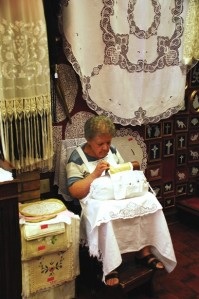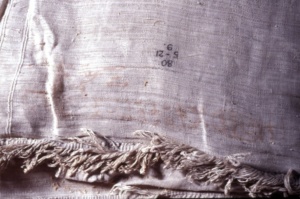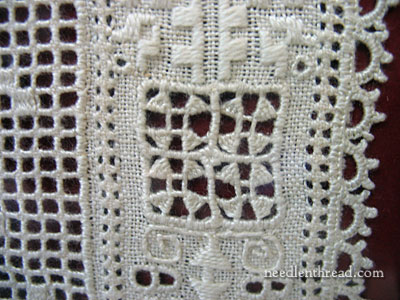Long ago a Venetian seafarer brought his beloved a gift of seaweed from the far, distant seas. She wanted to preserve the memento forever, so she painstakingly copied the delicate outline and patterns using her needle and thread. . .
So goes the legend of how lacemaking began in Venice and its surrounding islands, now renown for the art. Once, Venice and Burano Island were the lacemaking capitals of Europe. Other than its lacemaking, Burano Island is known as a fishing community. It is easy to see how the women of Burano – accustomed to sewing and repairing fishing nets – could take to the fine art of lace. Together, Venice and Burano filled orders for coronation robes and papal vestments as well as personal adornments for aristocrats and wealthy merchants across the continent.

Once, large workshops of women worked long days and nights like armies of spiders to create their diaphanous web-like creations. Today, sadly, handmade needle-lace is a dying artform. A few, often older women, sit stooped in their chairs with a pillow on their laps working on intricate borders and sewn ornaments.
Like most legends, the fisherman’s gift of seaweed to his paramour has a kernel of truth in it, but that kernel has been embellished with a dash of romanticism and a splash of whimsy. The kernel of truth is that lacemaking came to Venice from across the Mediterranean Sea – from Cyprus. The missing bit is that the origin of lacemaking can be traced to more than two millennia earlier in Egypt’s 18th Dynasty.

The earliest (and simplest) precursor of lace can be found in Egyptian mummy cloths. There sheet-like garments were used to wrap the dead in preparation for their journey to the afterlife and were usually made of finely woven linen decorated with fringes. Some mummy cloths had drawn thread work on them in which warp threads had been removed and embellishments added in the holes left by the missing threads.

Herodotus tells us that Pharaoh Amasis of Egypt (570 BC – 526 BC) sent finely woven linen to the Spartans, which, was made of no less than 360 threads (iii. 47); the figures woven on this cloth (drawn-thread or open work) were partly of linen and partly of gold thread. Herodotus also mentions a wonderful pallium sent by the same king to the shrine of Athene at Lindus. Amasis is also important in the lacemaking story for incorporating Cyprus into his kingdom.
By the Greco-Roman period, beginning in the 4th Century BCE, intricate selvedge borders routinely decorated the edges of mummy cloths and sometimes, complex beadworking decorated the hems of the cloths. It is easy to see how the patterning of the beads could be translated to stitch patterns for later lace borders.

Flash forward a thousand years and the Arabs are producing woven macramé. It is difficult to determine Cypriot Lefkara lace is a direct descendant of Egyptian drawn and open work or whether the Arab macramé tradition was an important influence on that development.
Either way, Venice begins its control of Cyprus as early as the late 12th Century. Although this is often called the “Frankish period”, Venice was the hidden hand in ruling the island, until taking direct control in 1481. It is probably during the Frankish period that the art of lacemaking is introduced.
As early as the end of the 14th Century, the Dogaresse Morosini (Doge Michele Morosini) begins to promote the art of lacemaking by forming a workshop of more than 130 women to create personal lace adornments for her and the nobility of allied states and countries in the form of gifts. Another Dogaresse, Giovanna Dandolo, wife of Doge Pasquale Malipiero protected and encouraged lacemaking in 1414 and soon lace had spread throughout Europe and become a fashion necessity for those who could afford it.
Today some five stitches are routinely done on Burano Island: Venetian, Rose Point, Point de Gaze, Alencon, and Argentan. This indicates a decrease from the 20th Century when Flowered Lace (Tagliato a fogliami) and Brussels point were also commonly used.
So, a artform that began in Egypt’s 18th Dynasty persists to this day in Venice’s nearby Burano Island. It is an art that is hanging on ‘by a thread’ and may soon be gone given the age of its masters both in Venice and Cyprus. To me, however, it is a voice from the Western Silk Road that continues to echo today. (Words by Laura Kelley; Photo of Burano Lacemaker by Laura Kelley, Photos of Mummy Cloths and Beadwork from the British Museum, Photo of Modern Macrame from Google Images and Photo of Lefkara Lace from Wikimedia.)

